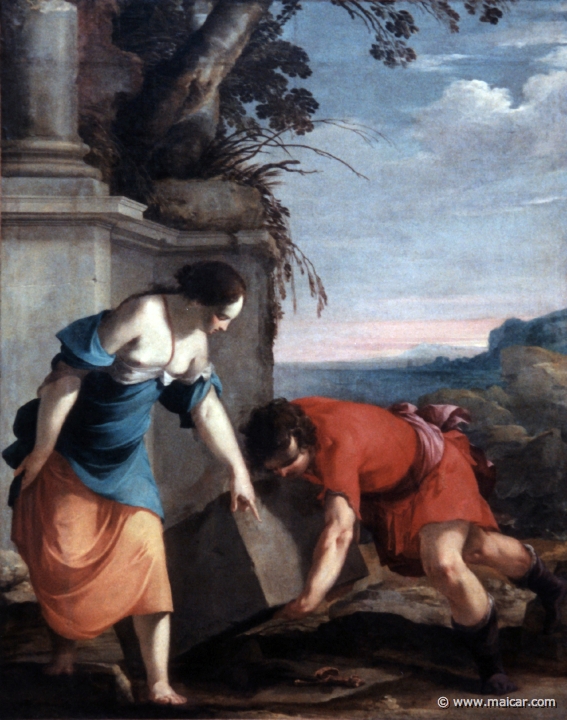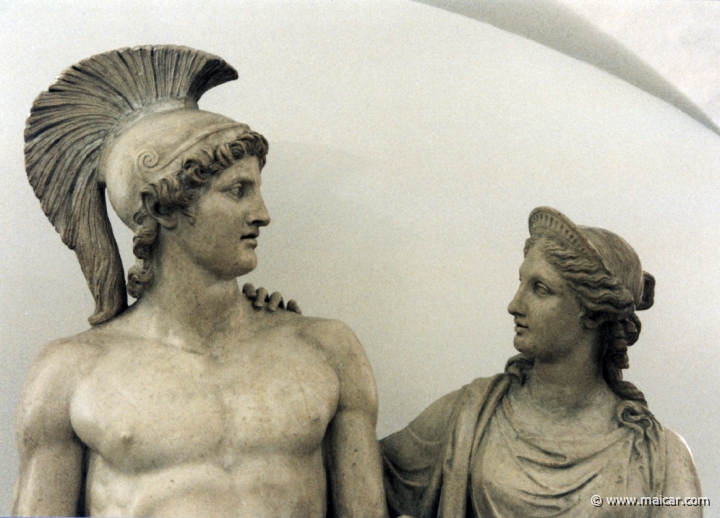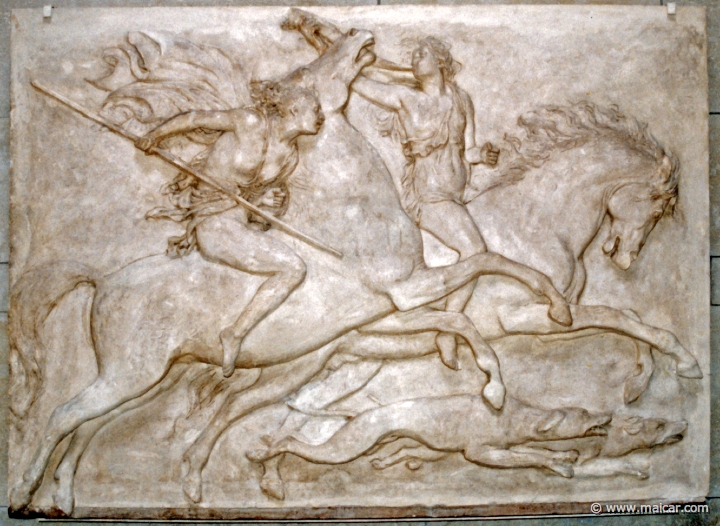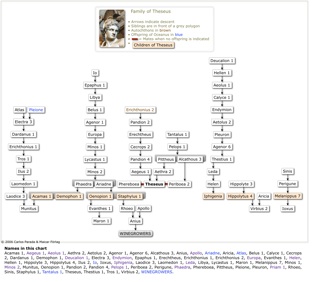 |
|
|

|
Theseus. 0509: Theseus besiegt den Kentauren. Statue by Antonio Canova, 1757-1822. Künsthistorische Museum, Wien.
|
|
|
"O futile humans! Why does your folly teach skills innumerable, and search out manifold inventions still? But there is one knowledge you do not gain and have never sought it: to implant a right mind where no wisdom dwells." (Theseus. Euripides, Hippolytus 919).
|
|
Theseus, king of Athens, punished the bandits that infested the road between this city and Troezen; he slew the Minotaur in Crete, and thanklessly abandoned the woman who had helped him. He also cursed his son, carried off another woman, and having descended to the Underworld, sat there on the Chair of Oblivion. He died in exile, but when he still was a ruler, he piously aided the Argives in recovering for burial the bodies of those who had fallen during the war of the SEVEN AGAINST THEBES.
Birth and Tokens
When King Aegeus 1 of Athens came to Troezen, King Pittheus (son of Pelops 1) made him drunk and caused him to lie with his daughter Aethra 2. A child was then conceived, but of uncertain father, since on the same night also Poseidon loved her. On leaving for Athens, Aegeus 1, who ignored that the god had been with the woman, told Aethra 2 that if she gave birth to a male child, she should rear him without telling who his father was. He then left a sword and sandals under a rock, saying that when his son could roll away the rock and take them up, she would send him to Athens. Aethra 2, not knowing herself who the father of her child was, did as instructed, and when Theseus was grown up, she showed him the rock, and he, pushing it away, took the sandals and the sword, and left for Athens.
Cleaning the way while traveling
On his way to Athens, Theseus cleansed the way of malefactors, making them suffer the same death that they inflicted on others. First he slew Periphetes 2, an evildoer who carried a club with which he dispatched the passers-by. Then he met Sinis, the man who used to force the passers-by to keep bending pine-trees until they were tossed up by them and perished. Employing this same method, Theseus sent Sinis to the next world, and when the criminal was dead, he ravished his daughter Perigune.
Beasts too
Thereafter Theseus met the Crommyonian Sow, offspring of Typhon, a fierce and hard to master beast that had killed many humans. This Sow, which had been bred by Phaea, gave birth to the notorious boar that was later killed by the CALYDONIAN HUNTERS, as some say. But others assert that Phaea was a female robber and murderer dwelling in Crommyon (a city between Megara and Corinth), who was called Sow because of her life and manners.
More bandits
Sciron was yet another bandit, whom Theseus met on his way to Athens. His inclination was to compel passers-by to wash his feet, and while they washed, he kicked them into the sea to be the prey of a huge turtle beneath. Him Theseus seized by the feet and threw into the sea. Then he met Cercyon 1, who compelled passers-by to wrestle, and in wrestling Theseus lifted him up and dashed him to the ground. Having him out of the way, Theseus ravished his daughter, like he had previously done with Perigune.
Strange ways to make adjustments
Then Theseus met Procrustes (also called Damastes and Polypemon), who offered hospitality to the passers-by, and laid the short men on a big bed and hammered them, to make them fit in the bed, but the tall men he laid on a little bed and sawed off the portions of their bodies that projected beyond it. Theseus felt that he had to punish this folly, and he killed Procrustes.
|

|
Guided by his mother Theseus finds the sword and the sandals. 4536: La Hyre Laurent de, 1606-1656: Thésée retrouvant les armes de son père. Musée des beaux arts, Caen.
|
|
Meeting with Medea
When after these encounters Theseus finally arrived to Athens, he found his alleged father Aegeus 1 wedded to Medea, the woman who committed several crimes in Hellas, having come from Colchis with Jason and the ARGONAUTS. And if this were so, then they are mistaken who affirm that Theseus is to be counted among the ARGONAUTS, since in that case the Colchian witch and Theseus would have known one another already. But as others say, Theseus had never met her before coming to Athens.
Plot in Athens
Medea, who had a child with Aegeus 1, disliked the newcomer, and sensing that he posed a threat, she accused Theseus of being a traitor, and her husband, still not knowing that Theseus was his son, sent him to tame the Marathonian Bull. When Theseus had killed, or at least mastered the beast, Medea, who by then had reached great achievements in the field of criminality (having killed her brother, the king of Iolcus, and her own children by Jason) decided to get rid of the young man as well by means of poison. But when Theseus was about to drink the potion that Medea had prepared, Aegeus 1 recognised the sword, and dashed the cup from his hands in the last moment. This is how father and son knew who they were, and having learned the truth, the king sent Medea into exile, a circumstance not at all unknown to her.
The Minotaur
At this time, the Athenians, who had been at war with King Minos 2 of Crete, were forced by him to send every year seven youths and seven young women as a tribute to the Minotaur. Theseus was numbered among those who were to be sent as the third tribute to the beast. But when he came to Crete, Minos 2's daughter Ariadne fell in love with him, and having obtained the secret to the Labyrinth from its constructor Daedalus, she disclosed the way out to Theseus. In the last part of the Labyrinth, Theseus found the Minotaur and killed him, and since he had been instructed by Ariadne, who had offered to help him if he would agree to carry her away to Athens and have her to wife, he found his way out. They both fled from Crete, but on arriving to Naxos (one of the Cyclades islands) Theseus deserted her.
Forgets the sails
Theseus had agreed with his father that he, when approaching Athens on his return from Crete, would spread white sails on his ship. But this detail he forgot, and Aegeus 1, seeing from the Acropolis the ship with a black sail, thought that his son had died, and in despair cast himself down and perished.
Consolidates power
On his father's death, Theseus was declared successor to the throne of Athens. But the fifty sons of Pallas 5 (the Pallantides), nobles of Attica, would not accept it, and they went to war. It was a certain Leos, who reported to Theseus the designs of the Pallantides and the ambush they had prepared against him. Theseus then fell suddenly upon the party lying in ambush, and slew them all. After the violent repression of the revolting faction, Theseus married Phaedra (also daughter of Minos 2) with whom he retired to Troezen in voluntary exile.
AMAZONS
|

|
0819: Theseus and Ariadne. Sculpture by Adamo Tadolini, 1788-1868. Pinacoteca Nazionale, Bologna.
|
|
It was about this time that Theseus made his his expedition against the AMAZONS, having a son Hippolytus 4 with one of the captives. But after his expedition the AMAZONS attacked Athens, and having organised their forces about the Areopagus, were vanquished by Theseus. Others say that when Theseus was celebrating his marriage to Phaedra, the Amazon that had before been married to him, mother of his son, appeared in arms with other AMAZONS, and threatened to kill the wedding guests who, having quickly closed the doors, killed her.
Phaedra and Hippolytus 4
Phaedra bore two children to Theseus, but she also fell in love with the son that Theseus had by the Amazon. However, Hippolytus 4, hating all women, fled from her, and Phaedra, fearing that he might accuse her to his father, falsely charged her stepson with an assault. Theseus believed her, and in anger prayed to Poseidon that Hippolytus 4 might perish; and so, when the young man was driving his chariot beside the sea, the god, listening to Theseus' curse, sent up a bull from the surf that frightened the horses and dashed the chariot to pieces, and Hippolytus 4, entangled in the reins, was dragged to death. To this some have added that Hippolytus 4, after having being raised from the dead by Asclepius, became king in Italy under the name of Virbius 1. In any case, when Phaedra's passion was made public, she hanged herself.
CENTAURS
After this domestic tragedy, Theseus and Pirithous, friends and brothers in arms (for they had fought together in the battle between the CENTAURS and the LAPITHS), decided that it would suit them perfectly to marry daughters of Zeus.
Brilliant ideas
This is why Theseus, with Pirithous' help, carried off Helen from Sparta for himself, when she was twelve years old. For this outrage, the DIOSCURI (brothers of Helen) ravaged Attica, and Theseus' mother was taken as a prisoner, and ended up in Troy as Helen's maid until her grandsons rescued her after the Trojan War. Pirithous had his own choice: he thought that Persephone would suit him as wife. So both friends descended to Hades in order to fetch her. But having been caught in the Underworld, they sat in the Chair of Oblivion until Heracles 1 came to Hades and rescued both, or perhaps only Theseus.
|

|
The AMAZONS attacked Athens and were vanquished by Theseus. 0112: Amazonentriptychon 1887. Mittelstück: Amazonenjagd. Adolf von Hildebrand 1847-1921. Neue Pinakotek, München.
|
|
Other rumours on the abduction of Helen
Some have said that Theseus was fifty years old when he abducted Helen, who was not, they say, of marriageable age. But those who care about Theseus' reputation have said that the girl was carried off by the Messenian brothers Idas 2 and Lynceus 1, the enemies of the DIOSCURI, and that Theseus just watched over her on their account and refused to surrender her to her brothers, the DIOSCURI. Others affirm that Theseus did not carry off Helen, but that her father Tyndareus entrusted her to him, for fear of Enarophorus, son of Hippocoon 2, who sought to take Helen by force while she still was a child. Yet Theseus and his accomplice Pirithous are still believed to have gone to Sparta, seizing Helen as she was dancing in a temple of Artemis. When they came out of Peloponnesus and felt out of danger, they cast lots for the girl and Theseus won. But as she was still too young, he conveyed her to Aphidnae and kept her there in complete secrecy.
Coup d'état, Exile and Death
When the DIOSCURI came from Sparta to get Helen back, they obtained a military vitory and gave the sovereignty of Athens to Menestheus 1, a member of the Athenian Royal House. Theseus then, forced to go into exile, came to Scyros (the island in the Aegean Sea northeast of Euboea), which was under the rule of King Lycomedes 1. It was in this island that Theseus died, perhaps killed by the king, said to have thrown his guest down an abyss, or for having simply slipped by himself and fallen down while walking in high places after supper, as was his custom.
|
| Family |
|
|
|
|
|
|
|
|
|
|
|
|
|
|
Aegeus 1 became king of Athens after expelling from the city the sons of Metion 1, son of Eupalamus, son of Erechtheus. During his reign, Athens had to
pay a hard tribute to Crete, until
Theseus, by killing the Minotaur, put
an end to this state of affairs. Aegeus 1 was son of Pandion 4 and Pylia, daughter of Pylas, son of Cleson, son of Lelex 2, king of Laconia and Sparta. Pandion 4 was son of Cecrops 2, son of Erectheus, son of Pandion 2, son of Erichthonius 2, an Autochthon or perhaps son of Hephaestus.
Aegeus 1 could not have children with his first wives, Meta, daughter of Hoples, and Chalciope 1, daughter of Rhexenor 1, but this inconvenience seems to have been corrected when he consorted with Aethra 2, daughter of Pittheus, son of Pelops 1, in Troezen, after
having visited the Oracle at Delphi.
Later he had a child Medus by Medea, whom he
expelled from Athens, after
her attempt to poison Theseus. For Aegeus 1's
death see main text above.
Theseus carried off Helen and brought
her to Aphidnae in Attica. But when he was
in the Underworld,
the DIOSCURI marched against the city, got possession
of Helen, and led Aethra 2 away captive. Theseus' mother then became the handmaid of Helen, but at the
end of the Trojan
War she was taken back to Athens by Demophon 1 and Acamas 1, sons of Theseus.
Aethra 2 was daughter of Pittheus, son of Pelops 1.
She committed suicide.
Aethra had a sister Henioche 3, who is said to be the mother, by Canethus 3, either of Sciron or of Sinis (see main text above).
|
|

Helen
|

Iphigenia
|
Iphigenia, who
otherwise is said to be the daughter of Agamemnon & Clytaemnestra was sacrificed at Aulis when the Achaean fleet could not saild because of contrary winds (see Trojan War). Some say, however, that when she was about to be sacrificed she, vanishing, was saved by Artemis who substituted
for her a deer at the altar and transported her to
Tauris (today called Crimea) where she later saved
her brother's (Orestes 2) life. According to some Helen, having been rescued
by the DIOSCURI, gave
her child Iphigenia to Clytaemnestra.
|
|

Phaedra
|
Demophon 1
|
Phaedra was daughter
of King Minos 2 of Crete & Pasiphae, or
as some say, of Minos 2 & Crete 1. She is known for having falling in love with her stepson Hippolytus 4, and, as he refused her, she falsely charged him of having assaulted her. As a result of this intrigue Phaedra hanged herself
when the scandal was made public.
Demophon 1
Demophon 1 fought in the Trojan War and is
counted among those who hid inside the WOODEN HORSE. After
the war, he asked Agamemnon for the freedom of his grandmother Aethra 2, who after the misadventure of Theseus with Helen and the destruction
of Aphidnae by the DIOSCURI, had become Helen's maid. Agamemnon granted his
request after receiving Helen's consent.
On his return from Troy, Demophon 1 came with a few ships to the land of the Thracian Bisaltians. There he became the lover of the king's daughter Phyllis 1, and her father gave her to him with the kingdom for her dowry. However, the wedding could not take place immediately because Demophon 1 wished to return to Athens, but he swore to return. When he departed, Phyllis 1, who was desperately in love with this man, made with him part of the road and when they parted company she gave him an enchanted casket containing a sacrament of the Mother of the Gods, which he was not to open until he knew for certain that he would not return to Thrace. Some say that he should had returned on an appointed day, and that on that day Phyllis 1 ran down to the shore nine times to see whether his sail showed up. When it became clear that Demophon 1 would not return, she hanged herself after cursing her lover. It is also said, however, that she died out of longing for him, and that round the tomb that her parents made for her, trees sprang that, at a certain season, grieve for her, their leaves growing dry and blowing away. And then again some say she prepared her own epitaph:
"Demophon sent
Phyllis to her doom. Her guest he was, she loved
him well. He was the cause that brought her death
to pass. Her own the hand by which she fell." (Ovid, Heroides 2.145).
In any case it is said that she thought that this would be a good inscription to be written under the image of Demophon 1 in Athens:
"This is he
whose wiles betrayed the hostess that loved him." (Ovid, Heroides 2.75).
By the time Phyllis 1 died Demophon 1 was in Cyprus, and so soon he opened the casket she had given him he felt invaded by panic. So, out of control, he mounted his horse, and when the animal stumbled he was thrown, fell on his sword and died.
|
|
Acamas 1
|
Acamas 1 fled when the DIOSCURI attacked Athens and destroyed Aphidnae during the absence of Theseus (see Helen). He went to Troy together with Diomedes 2 to ask for
the restoration of Helen and participated in the Trojan War, being
among those who hid inside the WOODEN HORSE. After the war, he brought back Aethra 2 who was captive in Troy. Acamas 1 had by Laodice 3 a son Munitus, who was killed by the bite of a snake while hunting at Olynthus in Thrace.
|
|
a) Hippolyte 3
b) Antiope 4
|

Hippolytus 4
|
(For the names of the mother of Hippolytus 4 see AMAZONS; for Hippolytus 4 see Romulus.)
|
|
Perigune
|
Melanippus 7
|
For Perigune see main text above. Melanippus 7 had a son Ioxus who led a colony in Caria, Asia Minor.
|
|

Ariadne
|
Oenopion 1
|
Of Oenopion 1, who is also called son of Dionysus 2 and Ariadne it is told that
he sailed from Crete and
settled in Chios. Later Orion came there and fell in love with Merope 3, his daughter. But Oenopion 1 made him drunk, put out his eyes as he slept, and cast him on the beach. But Orion was healed by the sun's rays, and having recovered his sight, he hastened against Oenopion 1. But for him Poseidon had made ready
a house under the earth constructed by Hephaestus.
|
|
Staphylus 1
|
Staphylus 1 is also said to be the son of Dionysus 2 and Ariadne.
|
|
Periboea 2
|
---
|
Periboea 2 was sent with Theseus to Crete in payment of the
tribute to Minos 2 (for this tribute see Athens). She was daughter of Alcathous 3, the son of Pelops 1 who is said to
have killed the Cithaeronian Lion.
|
|
Phereboea
|
---
|
|
|
|
|
|
|

|
Genealogical Charts
Names in this chart: Acamas 1, Aegeus 1, Aeolus 1, Aethra 2, Aetolus 2, Agenor 1, Agenor 6, Alcathous 3, Anius, Apollo, Ariadne, Aricia, Atlas, Belus 1, Calyce 1, Cecrops 2, Dardanus 1, Demophon 1, Deucalion 1, Electra 3, Endymion, Epaphus 1, Erechtheus, Erichthonius 1, Erichthonius 2, Europa, Evanthes 1, Helen, Hellen 1, Hippolyte 3, Hippolytus 4, Ilus 2, Io, Ioxus, Iphigenia, Laodice 3, Laomedon 1, Leda, Libya, Lycastus 1, Maron 1, Melanippus 7, Minos 1, Minos 2, Munitus, Oenopion 1, Pandion 2, Pandion 4, Pelops 1, Periboea 2, Perigune, Phaedra, Phereboea, Pittheus,
Pleione, Pleuron, Priam 1, Rhoeo, Sinis, Staphylus 1, Tantalus 1, Theseus, Thestius 1, Tros 1, Virbius 2, WINEGROWERS.
|
|
|
| Related sections |
Ariadne, Athens, Daedalus, Helen, Minos 2, Minotaur, Phaedra, Pirithous, Meeting Medea or not
Theseus in GROUPS: ARGONAUTS, CALYDONIAN HUNTERS, POSEIDON'S OFFSPRING, CONSTELLATIONS, LAPITHS
|
|
|
Sources
Abbreviations |
Apd.1.8.2, 1.9.16, 3.15.8;
Apd.Ep.1.7, 1.18, 1.24; Cic.ND.3.45; CYP.11;
Dio.4.28.3, 4.59.1; Eur.Hcl.208;
Eur.Her. passim; Eur.Hipp. passim;
Eur.Supp. passim; Hes.SH.181;
Hom.Il.1.265; Hyg.Ast.2.5, 2.6, 2.7;
Hyg.Fab.14; Lib.Met.27;
Ov.Fast.3.460ff.; Ov.Met.12.227; Pau.1.17.6,
2.22.6-7, 10.25.7; Plu.Cim.8.5;
Plu.PS.34; Plu.The.8.2, 20.2, 29.1-4,
31.3, 35.4; QS.13.497, 13.518; Soph.OC.1154 and passim;
Stat.Theb.5.432.
|
|
|